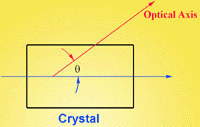|

Critical Phase Matching
|
The phase-matching can be obtained by angle tilting, temperature tuning or other methods. The angle tilting is mostly used to obtain phase-matching as shown in the left figure. If the angle between optical axis and beam propagation (q) isn't equal to 90o or 0o, we call itcritical phase-matching (CPM). Otherwise, 90o non-critical phase-matching (NCPM) is for q=90o and 0oNCPM is for q=0o.
|
Two types of phase-matching are classified in consideration of polarization of lasers. If the polarizations of two input beams (for sum frequency) are parallel to each other, it is called type I phase-matching. If the polarizations are perpendicular to each other, it is called type II phase-matching
|